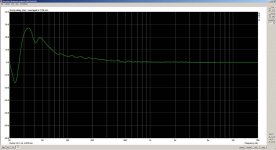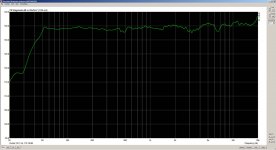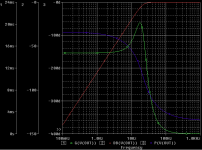Can you put up a circuit with values for GD of less than 2.5mS? Cut-off for HP might be 20Hz.
No, but you can DIY: http://sim.okawa-denshi.jp/en/Sallenkey3Hikeisan.htm
P.S. 2.5mS group delay for a 20Hz high pass, not a chance in hell other than digital.
Last edited:
.
Some other options might be to implement it in the Line level stage as a (switchable) filter with gain. Can you put up a circuit with values for GD of less than 2.5mS? Cut-off for HP might be 20Hz. Lets see what that would look like.
THx-RNMarsh
You need to specify what you want more carefully. If you want a total processing delay of 2.5mS what you state makes no physical sense, think about it. R, C and op-amp Sallen-Key filters are minimum phase.
There is a new school of phono preamp design that insists on using a flat preamp and EQ executed in digital. My instint is that the headroom, dynamic range and SNR would suffer with this approach. Have I missed something?
The problem is over stated, at 24 bits I think it can be proven that the surface noise will provide dither. I noticed something the other night the 33kHz noise peak on my MI cartridge was free noise shaped dither.
Check out the white paper (AES) on the Channel D site for their view not even considering self dither. CHANNEL D - Professional and Audiophile Quality Software for Vinyl, iTunes, and commercial applications
Last edited:
It is hard for me to understand the problem with group delay in a high pass filter for a record player. To specify 2.5 mS @ 20 Hz to me seems plain silly in the larger scheme of things.
Every loudspeaker is a high pass filter, minimum phase, with an associated phase shift of 180 degrees for closed, and 360 for vented enclosures (half of that in the region where it actually produces sound). Hilbert transform and all that. In the context of factual learnings of Netherlands for benefit of glorious mister Marsh, please have a quick look at this anechoic measurement of a vented speaker.

20 mS @ 50 Hz.
Every loudspeaker is a high pass filter, minimum phase, with an associated phase shift of 180 degrees for closed, and 360 for vented enclosures (half of that in the region where it actually produces sound). Hilbert transform and all that. In the context of factual learnings of Netherlands for benefit of glorious mister Marsh, please have a quick look at this anechoic measurement of a vented speaker.

20 mS @ 50 Hz.
Last edited:
I haven't gone into it enough to say all of the ways that it's a terrible idea (flat gain preamp and DSP EQ) but I suspect you are right, especially about dynamic range. I'm also in the midst of a phono preamp (having worked on it as a speculative investigation) and after about 15 years it is finally looking about optimal. The latest impetus was a guy who wanted a simpler device with passive (LCR) networks and gain blocks ahead and after. Also, I think a poor idea, although not as bad as a poorly-executed single feedback network approach, which has been the dominant design in the past.There is a new school of phono preamp design that insists on using a flat preamp and EQ executed in digital. My instint is that the headroom, dynamic range and SNR would suffer with this approach. Have I missed something? its important since I'm about to execute a phono to digital design and don't want my prejudices and resistance to new stuff to get in the way of a valid solution. Adding a DSP (The AD Sigma Studio Family SigmaStudio | product info The SigmaStudio | Analog Devices family are very good, simple to execute and cheap in quantity) would be not much more expensive than the 1% caps necessary for EQ. And it makes alternate EQ's for collectors easy.
The discussions in here about infrasonic signals have been illuminating. If there were to be a really compelling application for DSP and phono, I'd look for something like backing out the IM distortion associated with high-level infrasonic behavior---something along the lines of Klippel's mirror filters. It does sound perverse though, and I suspect one should just stay in the analog domain. Another possibility is additional accelerometry, sensing the headshell motion independently and using that signal to one's advantage.
What was the chamber cutoff frequency?It is hard for me to understand the problem with group delay in a high pass filter for a record player. To specify 2.5 mS @ 20 Hz to me seems plain silly in the larger scheme of things.
Every loudspeaker is a high pass filter, minimum phase, with an associated phase shift of 180 degrees for closed, and 360 for vented enclosures (half of that in the region where it actually produces sound). Hilbert transform and all that. In the context of factual learnings of Netherlands for benefit of glorious mister Marsh, please have a quick look at this anechoic measurement of a vented speaker.
View attachment 485421
20 mS @ 50 Hz.
Brad
It is the room of the Technical University Delft and they don't know .
.
They used to have an audio group at the technical physics department, but nowadays only the anechoic room is left with a techie to open the door; it is just some left over infrastructure that can be rented by Dutch companies. I didn't measure it, but it must be about >10m in each direction, with man sized glass fiber wedges. I doubt it is true at 50Hz, but measurements don't show signs of standing waves even at that frequency, see the FR of the same measurement from which the GD was derived.

It is the room of the Technical University Delft and they don't know
They used to have an audio group at the technical physics department, but nowadays only the anechoic room is left with a techie to open the door; it is just some left over infrastructure that can be rented by Dutch companies. I didn't measure it, but it must be about >10m in each direction, with man sized glass fiber wedges. I doubt it is true at 50Hz, but measurements don't show signs of standing waves even at that frequency, see the FR of the same measurement from which the GD was derived.

it must be about >10m in each direction, with man sized glass fiber wedges. I doubt it is true at 50Hz,
but measurements don't show signs of standing waves even at that frequency.
That's huge, it probably does go to 50HZ. We only had a 10' chamber that was good to about 100Hz at best.
It's the wedge size mainly. And the wedges have to get really big. Of course you have to have a big room to accommodate the wedges. At some point you pretty much have to go outside.
A writer recently argued about some bass characteristic of the (in)famous Yamaha NS-10. His preconceptions were allegedly confirmed by anechoic measurements, but the problem was he believed chamber data that was well below the chamber cutoff. It has become an embarrassment, sadly, exacerbated by a stubborn streak.
A writer recently argued about some bass characteristic of the (in)famous Yamaha NS-10. His preconceptions were allegedly confirmed by anechoic measurements, but the problem was he believed chamber data that was well below the chamber cutoff. It has become an embarrassment, sadly, exacerbated by a stubborn streak.
At some point you pretty much have to go outside.
Yes, but you only have to do it once (with the lowest woofing cabinet you can come up with), to develop a standard against which to calibrate your anechoic room in its non-linear region.
Edit: a large crane and a wind still piece of desert are required as well.
No, but you can DIY: 3rd order Sallen-Key High-pass Filter Design Tool
P.S. 2.5mS group delay for a 20Hz high pass, not a chance in hell other than digital.
I might try a quick filter on the proto-board because i can measure GD with instrumentation. However, since the subject is so thoroughly known, somewhere is data on it already.
I dont have an LP system any more ... this and a hundred other issues with LP's made me run from it as soon as there were other options to explore.
I just want to point this very audible (even by SY's standards) GD issue out again as in the electronics side (rather than speakers) it is known but almost forgotten issue to address.
The 2.5ms comes from the literature as to what is audible. In speakers it might be harder to do but GD reduction must be attempted or minimized to claim SOTA. And, it does not imply that because a speaker's LF GD is larger, that a further reduction in the electronics system that GD won't be noticed.
The Sal-Key offers a lot of potential with its buffer (no gain) low cost topology used. It's ability to remove significant unwanted low freq has always been a plus for LP systems. But, do it with low GD..... what topology is needed to minimize GD for the HP filter?
THx-RNMarsh
Last edited:
Based on my own experience with a 6 dB/Oct. 20 Hz subsonic filter and my bass reflex speakers with its port tuned to 35 Hz, what you wrote is exactly what happens.
Switch the filter on and the bass lnes become cleaner, clearer and better controlled. No doubt some phase shift is added, and that seems to be the key trade-off, perhaps a very slightly volume reduced sound at the very lowest of frequencies (that I have), some added phase shift for better control of the bass driver and better overall clarity of the bass lines.
Speaking strictly with the preamps I own and know (Luxman C-03, H/K Citation 21, Marantz 3256b and Philips AH286), all of which have very similar high pass filters centered at 20 Hz, the effect is virtually the same, their other differences notwithstanding. It's a trade-off, but in my view, a very acceptable one because the pros are greater than the cons.
Better yet, this is further confirmed when using speakers with less bass extention, like AR94 (nominally -3 dB @ 44 Hz) and JBL Ti600 (nominally -3dB @ 45 Hz).
I haven't gone into it enough to say all of the ways that it's a terrible idea (flat gain preamp and DSP EQ) but I suspect you are right, especially about dynamic range.
There are many folks doing it and happy with the result.
The 2.5ms comes from the literature as to what is audible.
Maybe in the KHz range, but at 20Hz? It doesn't make any sense. Please come up with an authoritative reference about this.
Attached is the gain (red), phase (blue) and group delay (green) of a 3rd order Sallen-Key high pass filter, tuned at some 18Hz. Group delay is one order of magnitude higher than your target.
Attachments
Last edited:
As I'm not involved in any kind of hi-end religion, I use, when i feel-it necessary, hi-pass filters or tonal correction, listening some records. And don't worry too much about the consequences in phase rotations as long it sound...better with than without !
That is most often the case, reason why i needed this correction
Notice that there are very few instruments, in your favorite records, that were not corrected (with an analog or digital corrector) before to be incorporated in the mix. The bride is not a virgin.
That is most often the case, reason why i needed this correction
Notice that there are very few instruments, in your favorite records, that were not corrected (with an analog or digital corrector) before to be incorporated in the mix. The bride is not a virgin.
Re GD........ Check out the AES, Waly.
You ought to know me by now--- I always ask for the impossible and we come pretty close to doing it most of the time.
Yes, I also know you are pushing lots of BS here, and then you dismissively fail to quote any precise source when asked to support your statements.
Yes, but you only have to do it once (with the lowest woofing cabinet you can come up with), to develop a standard against which to calibrate your anechoic room in its non-linear region.
Edit: a large crane and a wind still piece of desert are required as well.
You really can't calibrate it. The standing wave effects are going to be non-minimum phase.
Waly, your point notwithstanding, there's really no need for strong language. Some people, myself included, feel that Richard's general statements on what happens when one activates a low pass filter at 20 Hz are spot on even without reading tons of AES papers. I don't actually need papers to tell me what I can easily hear all by myself.
- Status
- Not open for further replies.
- Home
- Member Areas
- The Lounge
- John Curl's Blowtorch preamplifier part II
